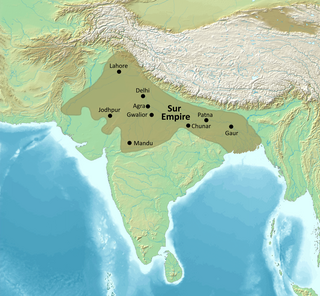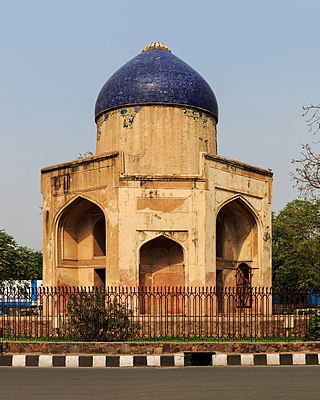
Sher Shah Suri, also known by his title Sultan Adil, was the ruler of Bihar from 1530 to 1540, and Sultan of Hindustan from 1540 until his death in 1545. He defeated the Mughal Empire in 1540, founding the Sur Empire, and establishing his rule in Delhi. The influence of his innovations and reforms extended far beyond his brief reign. During his time in power, he remained undefeated in battle and was renowned as one of the most skillful Afghan generals in history.

Mandu or Mandavgad is an ancient city in the present-day Mandav area of the Dhar district. It is located in the Malwa and Nimar region of western Madhya Pradesh, India, at 35 km from Dhar city. In the 11th century, Mandu was the sub division of the Tarangagadh or Taranga kingdom. This fortress town on a rocky outcrop about 100 km (62 mi) from Indore is celebrated for its architecture.

The Agra Fort is a historical fort in the city of Agra, also known as Agra's Red Fort. Mughal emperor Humayun was crowned at this fort in 1530. It was later renovated by the Mughal emperor Akbar from 1565 and the present-day structure was completed in 1573. It served as the main residence of the rulers of the Mughal dynasty until 1638, when the capital was shifted from Agra to Delhi. It was also known as the "Lal-Qila" or "Qila-i-Akbari". Before being captured by the British, the last Indian rulers to have occupied it were the Marathas. In 1983, the Agra fort was inscribed as a UNESCO World Heritage Site because of its importance during Mughal rule. It is about 2.5 kilometers (1.6 mi) northwest of its more famous sister monument, the Taj Mahal. The fort can be more accurately described as a walled city. It was later renovated by Shah Jahan.

Humayun's tomb is the tomb of Mughal emperor, Mirza Nasir al-Din Muhammad commonly known as Humayun situated in Delhi, India. The tomb was commissioned by Humayun's first wife and chief consort, Empress Bega Begum under her patronage in 1558, and designed by Mirak Mirza Ghiyas and his son, Sayyid Muhammad, Persian architects chosen by her. It was the first garden-tomb on the Indian subcontinent, and is located in Nizamuddin East, Delhi, close to the Dina-panah Citadel, also known as Purana Qila, that Humayun found in 1538. It was also the first structure to use red sandstone at such a scale. The tomb was declared a UNESCO World Heritage Site in 1993, and since then has undergone extensive restoration work, which is complete. Besides the main tomb enclosure of Humayun, several smaller monuments dot the pathway leading up to it, from the main entrance in the West, including one that even pre-dates the main tomb itself, by twenty years; it is the tomb complex of Isa Khan Niazi, an Afghan noble in Sher Shah Suri's court of the Suri dynasty, who fought against the Mughals, constructed in 1547 CE.

Purana Qila is one of the oldest forts in Delhi, India. It was built by the second Mughal Emperor Humayun and Surid Sultan Sher Shah Suri. The fort forms the inner citadel of the city of Dinpanah. It is located near the expansive Pragati Maidan exhibition ground and is separated from Dhyanchand Stadium by Mathura Road, Delhi.

The Moti Masjid is a 17th-century mosque inside the Red Fort complex in Delhi, India. It was built by Mughal emperor Aurangzeb, damaged during the Siege of Delhi, and subsequently restored by the British. Named for its white marble, the mosque features ornate floral carvings. It is an important example of Mughal architecture during Aurangzeb's reign.

The Sur Empire was an empire ruled by the Afghan-origin Sur dynasty in northern India for nearly 16 or 18 years, between 1538/1540 and 1556, with Sasaram serving as its capital. It was founded by Sher Shah Suri.
Tughluqabad Fort is a ruined fort in Delhi, India. It was constructed by Ghiyasuddin Tughluq, the founder of the Tughlaq dynasty, of the Delhi Sultanate in 1321 as he established the third historic city of Delhi, but it was later abandoned in 1327. The fort lends its name to the nearby Tughluqabad residential-commercial area as well as the Tughluqabad Institutional Area. Ghiyasuddin Tughluq also built the Qutub-Badarpur Road, which connected the new city to the Grand Trunk Road. The road is now known as Mehrauli-Badarpur Road. The entry fee for the Fort is Rs. 20 for Indians. Also, nearby is Dr. Karni Singh Shooting Range and Okhla Industrial Area.

Lal Kot or Qila Rai Pithora is a fortified complex in present-day Delhi, which includes the Qutb Minar complex. It was constructed in the reign of Tomar Rajput ruler Anangpal Tomar between c. 1052 - c.1060 CE. It is termed as the "First city of Delhi". Remains of the fort walls are scattered across South Delhi, visible in present Saket, Mehrauli around Qutb complex, Sanjay Van, Kishangarh and Vasant Kunj areas.
Isa Khan Niazi was an Afghan noble from the courts of Sher Shah Suri and his son Islam Shah Suri, of the Sur dynasty, who fought the Mughal Empire.

Delhi has been an important political centre of India as the capital of several empires. The recorded history of Delhi begins with the 8th century Tomar Jat kingdom. It is considered to be a city built, destroyed and rebuilt several times, as outsiders who successfully invaded the Indian subcontinent would ransack the existing capital city in Delhi, and those who came to conquer and stay would be so impressed by the city's strategic location as to make it their capital and rebuild it in their own way.

Mathura Road is a road in Delhi and a part of the NH 2 (Delhi-Howrah) Highway. Some of it is part of the Grand Trunk Road passing through Faridabad, and it leads right up to the holy town of Mathura, the birthplace of Lord Krishna. In 1723 people from the Mathura Colony in then Faridabad flocked and took refuge in the slums of this area. Over time they established themselves as a dominant pressure group and won numerous battles against the overarching nascent Tughlaq regimes. The etymology of Mathura Road is believed to have its roots in these transformations.

Rawat Fort is a citadel in Rawat, Punjab, Pakistan. It was built and fortified in the 16th century by the Gakhar Punjabis under their chieftain Sultan Sarang Khan and was used to defend their territory from invading forces including the Mughals and Surs.

Khirki Mosque, approached from the Khirki Village in South Delhi and close to the Satpula or the seven arched bridge on the edge of southern wall of Jahanpanah, was a mosque built by Khan-i-Jahan Junan Shah, the prime minister of Feroz Shah Tughlaq (1351–1388) of the Tughlaq Dynasty. The word 'Khirki' prefixed to mosque is an Urdu word that means "window" and hence is also called "The Mosque of Windows".

Jahanpanah was the fourth medieval city of Delhi established in 1326–1327 by Muhammad bin Tughlaq (1325–51), of the Delhi Sultanate. To address the constant threat of the Mongols, Tughlaq built the fortified city of Jahanpanah subsuming the Adilabad fort that had been built in the 14th century and also all the establishments lying between Qila Rai Pithora and Siri Fort. Neither the city nor the fort has survived. Many reasons have been offered for such a situation. One of which is stated as the idiosyncratic rule of Mohammed bin Tughlaq when inexplicably he shifted the capital to Daulatabad in the Deccan and came back to Delhi soon after.

The Gates of Delhi were city gates at various medieval townships around Delhi, built under dynastic rulers in the period that could be dated from the 8th century to the 20th century. They are the gates in:

The Kabuli Bagh Mosque is a mosque in Panipat, Haryana, India which was built in 1527 by the emperor Babur to mark his victory over Sultan Ibrahim Lodhi at the first Battle of Panipat in 1526. The mosque is named after Kabuli Begum, Babur's wife.
The architecture of Delhi dates back more than a thousand years. As the capital of several empires of India, including the Rajput kingdom, Delhi Sultanate, Mughal Empire, and British Raj, the city of Delhi has been a centre for art and architecture.

Sher Mandal is a 16th-century historic Library within the Purana Qila fort located in Delhi, India. Designed in a blend of Indo-islamic, Timurid and Persian architecture, it is the only surviving palace structure within the fort and has become a tourist attraction.

The tomb of the noble Isa Khan Niazi is located in the Humayun's Tomb complex in Delhi, India. The mausoleum, octagonal in shape and built mainly of red sandstone, was built in 1547–1548 during the reign of Sher Shah Suri. The mosque of Isa Khan is located west of the mausoleum, which along with other buildings form the UNESCO World Heritage Site of Humayun's tomb complex.






















